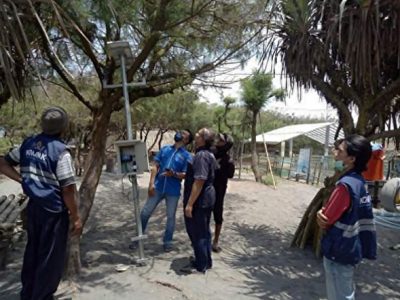Automatic Turtle Nest Monitoring Tool

Turtles are reptiles that live in the sea. Turtles can migrate long distances along the Indian Ocean, Pacific Ocean, and Southeast Asia. The existence of turtles in a tricky situation by nature and human activities that directly or indirectly endanger the population. These animals are sensitive to light, noise, environment cleanliness, and crowds which often disturb turtles laying eggs. Damage to coastal habitats, deaths due to interactions with fishing activities, inadequate management of conservation techniques, and uncontrolled hunting of turtles and their eggs are factors causing the decline in turtle populations due to human activities—threats from nature in the form of climate change, disease, or the threat of predatory animals.
Turtle breeding is highly dependent on climate change and weather factors. Therefore, several lecturers from the Faculty of Engineering designed a turtle breeding monitoring tool prototype. This tool has a sensor system that can detect the temperature and humidity conditions of the environment (air and sand). Monitoring can be done remotely using an Android application and web browser based of IoT. The development team for this monitoring tool consists of Purno Tri Aji, M.Eng., Muhammad Irfan Luthfi, M.Pd., Muhammad Izzuddin Mahali, M.Cs, Dr. Eko Marpanaji, and two students, namely Danang Wijaya and Muhammad Dzulfiqar Amien.
According to Purno Tri Aji, cold weather changes can hinder the hatching of turtle eggs. When the temperature is cold, the turtle egg hatching failure rate can reach 50%. “The cold weather prevents many turtle eggs from hatching because of the lack of heat in the nests under the sea sand. In addition, cold weather will hamper the incubation time of turtle eggs," he said Saturday (20/8). Under normal weather conditions, equivalent to 30 degrees Celsius, turtle eggs will hatch after 40 days of incubation, while in cold weather, around 20 degrees Celsius, turtle eggs will hatch after 55 days. The wet-dry season also significantly affected the hatching of turtle eggs in semi-natural nests on the southern coast of Java. The condition of this season causes the sand in the semi-natural nest to be moist so that the turtle egg embryos do not develop appropriately into hatchlings and even fail to hatch. In addition, the damp sand conditions can trigger the entry of organisms through the pores of the eggshell which causes decay in the egg embryo so that the turtle eggs fail to hatch.
Muhammad Irfan Luthfi added that turtle conservation activities include several activities:
1.Monitoring turtles laying eggs and hatching eggs naturally.
2.Captive breeding (starting from egg transfer activities, semi-natural hatching, maintenance of hatchlings to releasing hatchlings).
3.Monitoring or monitoring turtles (including monitoring of eggs and nests, hatchlings, and turtles laying eggs).
4.Tagging, saving turtles in migration areas and fostering natural and semi-natural habitats.
Irfan also explained that the management of turtle-based tourism was also a concern of the UNY team. This activity involves ten members of the konservasi penyu pantai pelangi as part of downstream the results of the research and development of the UNY lecturer team based on community service.
Apart from the tool installment, members of the konservasi penyu pantai pelangi are given practical training in tool troubleshooting. At the end of the activity, the lecturer team monitored and evaluated the progress of monitoring tools already installed at the location. Participants provided feedback related to the tool's results and the obstacles in using the tool. The lecturer team provides direction, input, and solutions related to feedback from the participants. The participants felt very helpful with this training activity. (Dedy, Tj. Lak)

